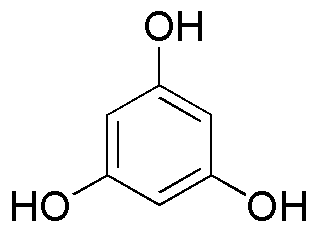Phloroglucinol (anhydrous) is widely utilized in research focused on:
- Pharmaceutical Development: It serves as a key ingredient in medications for gastrointestinal disorders, providing relief from spasms and pain.
- Analytical Chemistry: Used as a reagent in various analytical techniques, it helps in the detection and quantification of certain compounds, enhancing accuracy in research labs.
- Food Industry: Acts as a flavoring agent and preservative, contributing to the stability and taste of certain food products.
- Cosmetic Formulations: Incorporated into skincare products for its antioxidant properties, improving skin health and appearance.
- Research in Plant Biology: Utilized in studies to understand plant responses to stress, aiding in the development of more resilient crop varieties.
Información general
Propiedades
Seguridad y normativas
Aplicaciones
Phloroglucinol (anhydrous) is widely utilized in research focused on:
- Pharmaceutical Development: It serves as a key ingredient in medications for gastrointestinal disorders, providing relief from spasms and pain.
- Analytical Chemistry: Used as a reagent in various analytical techniques, it helps in the detection and quantification of certain compounds, enhancing accuracy in research labs.
- Food Industry: Acts as a flavoring agent and preservative, contributing to the stability and taste of certain food products.
- Cosmetic Formulations: Incorporated into skincare products for its antioxidant properties, improving skin health and appearance.
- Research in Plant Biology: Utilized in studies to understand plant responses to stress, aiding in the development of more resilient crop varieties.
Documentos
Hojas de datos de seguridad (HDS)
La SDS proporciona información de seguridad completa sobre la manipulación, el almacenamiento y la eliminación del producto.
Especificación del producto (PS)
La PS proporciona un desglose completo de las propiedades del producto, incluida la composición química, el estado físico, la pureza y los requisitos de almacenamiento. También detalla los rangos de calidad aceptables y las aplicaciones previstas del producto.
Certificados de análisis (COA)
Busque certificados de análisis (COA) ingresando el número de lote del producto. Los números de lote y de partida se pueden encontrar en la etiqueta de un producto después de las palabras "Lote" o "Lote".
Número de catálogo
Número de lote/lote
Certificados de origen (COO)
Este certificado de origen confirma el país en el que se fabricó el producto y también detalla los materiales y componentes utilizados en él y si se deriva de fuentes naturales, sintéticas u otras fuentes específicas. Este certificado puede ser necesario para cumplir con las normativas aduaneras, comerciales y regulatorias.
Número de catálogo
Número de lote/lote
Hojas de datos de seguridad (HDS)
La SDS proporciona información de seguridad completa sobre la manipulación, el almacenamiento y la eliminación del producto.
DownloadEspecificación del producto (PS)
La PS proporciona un desglose completo de las propiedades del producto, incluida la composición química, el estado físico, la pureza y los requisitos de almacenamiento. También detalla los rangos de calidad aceptables y las aplicaciones previstas del producto.
DownloadCertificados de análisis (COA)
Busque certificados de análisis (COA) ingresando el número de lote del producto. Los números de lote y de partida se pueden encontrar en la etiqueta de un producto después de las palabras "Lote" o "Lote".
Número de catálogo
Número de lote/lote
Certificados de origen (COO)
Este certificado de origen confirma el país en el que se fabricó el producto y también detalla los materiales y componentes utilizados en él y si se deriva de fuentes naturales, sintéticas u otras fuentes específicas. Este certificado puede ser necesario para cumplir con las normativas aduaneras, comerciales y regulatorias.


